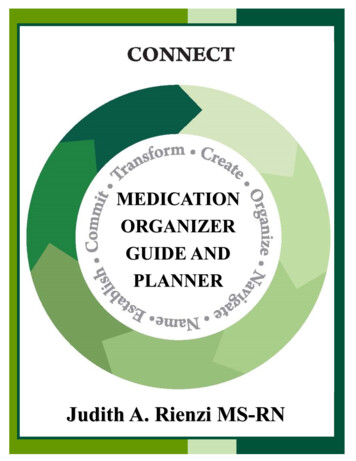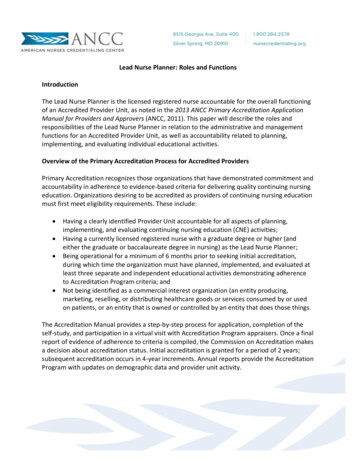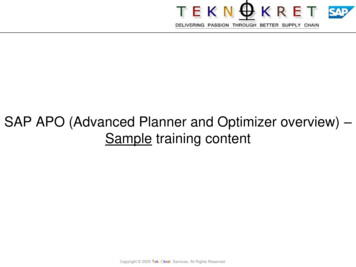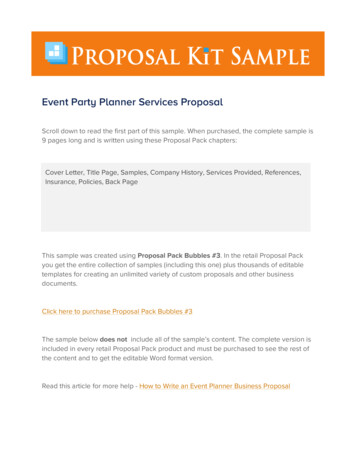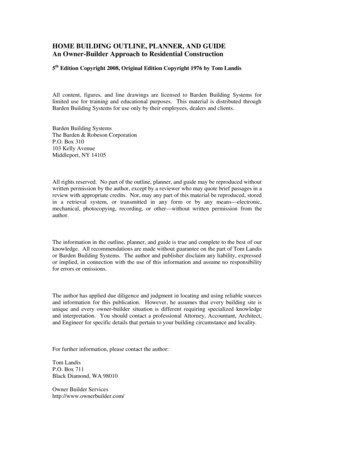
Transcription
HOME BUILDING OUTLINE, PLANNER, AND GUIDEAn Owner-Builder Approach to Residential Construction5th Edition Copyright 2008, Original Edition Copyright 1976 by Tom LandisAll content, figures, and line drawings are licensed to Barden Building Systems forlimited use for training and educational purposes. This material is distributed throughBarden Building Systems for use only by their employees, dealers and clients.Barden Building SystemsThe Barden & Robeson CorporationP.O. Box 310103 Kelly AvenueMiddleport, NY 14105All rights reserved. No part of the outline, planner, and guide may be reproduced withoutwritten permission by the author, except by a reviewer who may quote brief passages in areview with appropriate credits. Nor, may any part of this material be reproduced, storedin a retrieval system, or transmitted in any form or by any means—electronic,mechanical, photocopying, recording, or other—without written permission from theauthor.The information in the outline, planner, and guide is true and complete to the best of ourknowledge. All recommendations are made without guarantee on the part of Tom Landisor Barden Building Systems. The author and publisher disclaim any liability, expressedor implied, in connection with the use of this information and assume no responsibilityfor errors or omissions.The author has applied due diligence and judgment in locating and using reliable sourcesand information for this publication. However, he assumes that every building site isunique and every owner-builder situation is different requiring specialized knowledgeand interpretation. You should contact a professional Attorney, Accountant, Architect,and Engineer for specific details that pertain to your building circumstance and locality.For further information, please contact the author:Tom LandisP.O. Box 711Black Diamond, WA 98010Owner Builder Serviceshttp://www.ownerbuilder.com/
OverviewWhat is involved in the B.Y.O.B. Program?The ultimate goal of the Build Your Own Barden (B.Y.O.B.) Program is to create a home to match yourfamily’s lifestyle. Your vision will guide the entire project. For this reason, Barden Building Systemsputs you, the Owner, at the center of all decisions.Roles & ResponsibilitiesConstructing your new home will require the participation of a variety of professionals including: Real-Estate Agent – Responsible for assistingthe Owner in buying and selling land, andusually coordinates various aspects of theclosing when the property deed is transferred.Construction Lenders – Responsible forlending money to the Owner to purchaseland and/or the house. (Most often, theland and house are used as security untilthe loan is paid in full.)Construction Manager (C.M.) or General Contractor(G.C.) Acting as CM – Responsible for assistingthe Owner in planning, organizing, andcontrolling the B.Y.O.B. process to ensurethe Owner's best interest is maintainedfrom start to finish. (If you have chosen toact as General Contractor (G.C.) under thisB.Y.O.B. program, you may want toconsider hiring your Barden BuildingSystems dealer to act as your ConstructionManager under a Personal ServiceAgreement. In this way, you benefit from his/her connections in and knowledge ofthe industry but s/he may be involved aslittle or as much as you deem necessary.)Architect/Designers–Responsible forcreation of Drawings & Specificationsfollowing the requirements provided by theOwner orienting house and the site tofamily lifestyle prior to and duringconstruction.Civil & Structural Engineers – Responsible forproviding scientific knowledge to solveconstruction problems related to geologicaland structural conditions during creation ofDrawings and Specifications.section one page 1
Specialty Trade Contractors (such as plumbers,electricians, painters, etc.) – Responsiblefor providing trade labor and bid proposalsat each phase of construction adhering toDrawings and Specifications, and are accountable directly to the Owner.Suppliers & Manufacturers - Responsible forproviding material and products at eachphase of construction adhering to Drawingsand Specifications, and are accountabledirectly to the Owner.Plan Examiner & Field Inspector – Responsiblefor reviewing Design/Build criteria bothprior to and during the construction processto maintain compliance with applicablecodes and ordinances in your area.Each construction professional should dedicate his/her activities to serving the Owner's bestinterest. Under the B.Y.O.B. Program, the Owner acts as the General Contractor, leading theentire construction organization. With the possible assistance of a Construction Manager, theOwner contracts all services to save costs, maintain standards for quality, and provide personalattention to all phases of the Design/Build process.So, Do You Want to B.Y.O.B.?Do you want to be your own General Contractor under the B.Y.O.B. program? To determinewhether or not you “have what it takes,” ask yourself these questions:1.2.3.4.Do I have the time to dedicate 10-20 hours a week to the G.C. job each week?Am I tenacious enough to communicate effectively with professionals when we disagree?Can I make decisions quickly and confidently?Am I a good planner who remains organized from the beginning to the end of a project?If you’ve been honest with yourself and answered yes to these questions, then you may havewhat it takes to undertake the B.Y.O.B. program. If not, then you should follow the more traditionalroute of hiring a General Contractor for your home building project. Or, you could hire your Barden BuildingSystems dealer to act as your Construction Manager under a Personal Service Agreement.section one page 2
Decision-making & Project Management ProcessIt’s important to be a good decision maker to overcome the kinds of problems that customarilyarise on any project—budgets, deadlines, conflicting priorities, and the inherent complexities oforganizing people with different expertise into an effective team. Follow these simple bestpractices when making decisions for your project:1. Pre-qualify with your lender.2. Know your site before you buy land.3. Plan with a systems view of thewhole process.4. Build it on paper with a complete setof Drawings & Specifications.A key to effectively managing yourconstruction project to recognize it is ahighly interdependent system. Byseeing the connections, you canunderstand the roles and contributionsof the various players, and makeeffective, informed decisions. (Forinstance, where you locate your homeon site determines logistics for materialdelivery and utilities layout.Aseemingly terrific location may end up alogistical nightmare – or worse, result inthe denial of a building permit.) TheDECISION-MAKING MODEL illustratesthe information-sharing and decisionmaking system of your residentialconstruction project. As you can see,each professional provides specializedinformation and services, yet each relies on the others for guidance throughout the process.Although an optimistic "can do" attitude by the Owner is admirable, be mindful that thesespecialties exist out of necessity. Defining the requirements of your lifestyle, generatingDrawings & Specifications, determining a budget and schedule, and locating trade contractorsand suppliers are major undertakings. Decision making begins early in the process, so it isimportant to collaborate with the team (and your attorney/accountant) as soon as possible. ThisB.Y.O.B. Guide was written to help you anticipate problems! Remember, you, the Owner,should be at the center of all decisions.section one page 3
Staying OrganizedAnother consideration for the Owner is how to stay organized throughout the Design/Build process tomanage the project and make decisions efficiently and effectively. You have two choices: amanual or an automated system for information storage and referral. A manual system relies onfiles, checklists, and the traditional “paper and pencil” techniques. An automated systemincorporates computer hardware, construction management software, and an electronicapproach to information processing.Barden Building Systems encourages you to use a manual system. For a one-time use on aconstruction project, a considerable amount of time will be dedicated to training for anddevelopment of a software system geared toward construction management. Rather thanexpend the time and effort, not to mention costs, to develop a proficiency in the use of asoftware system, you should concentrate on the primary goal of Project Management: to create ahome which meets the needs of your lifestyle.Following a manual approach allows you to begin immediately with the Design/Build process,analyze the circumstances of the project, and concentrate on decisions which directly relate toProject Management. You might consider acquiring a construction calculator (one manufactureris Calculated Industries) to help you solve building problems in the feet-inch format whenfiguring material quantities, unit costs, stair and roof layout, square footage, and volumecalculations. The instructions are easy to understand, and you can begin using the calculatorimmediately.However, if you are proficient in the use of a computer, by all means use the standard desktopword processing, spreadsheet, email and browser capabilities. Microsoft Outlook is a standardfeature on all Microsoft Desktops. Its features include a Calendar, Contact Manager, DraftsFolder, Email Inbox/Outbox, Journal, Notes and Tasks. This will be all you need to supplementa manual approach to Project Management. Owners with computer skills can easily begin withwhat they already know and progress into more efficient desktop applications. The result ofsupporting a manual system with a construction calculator and Microsoft Outlook creates ahybrid method combining small-scale automated system with traditional paper and penciltechniques. When analyzing and recording information for decision making, the Owner shouldutilize available technology yet realize the need to get on with the tasks of Project Management.section one page 4
Project GuideFor the Owner with an optimistic "can do" attitude, the DESIGN/BUILD process may seemmanageable – and indeed it can be if you stay organized. The DESIGN/BUILD MATRIX belowhelps you “compartmentalize” the complex information so that you can make decisions sensiblyand sequentially. The matrix allows the Owner to focus on one block of information at a time.First, you will need to translate the requirements of your lifestyle into Contract Documents whichwill direct all activities for your B.Y.O.B. home building project.Note that the matrix has two dimensions: the DESIGN dimension (which sequences theflow of major events for creation of Drawings and Specifications), and the BUILDdimension (which sequences the flow of major events during construction). To manageyour project, you will need to operate in both dimensions.section two page 1
Both dimensions focus on the Owner's requirements for the house and site. As such,you will need more than a tangle of ideas. Designing your home will be a process of“progressive approximation” where ideas are presented, problems identified, solutionsconsidered, and decisions refined and finally implemented. As you concentrate on eachblock of information, you will progress toward a final solution which graduallyapproximates WHAT products and materials will be used for creation of your homestyle.It begins with vague notions and ends with specific choices.The DESIGN phase AND the BUILD phase ARE INTERDEPENDENT and take intoconsideration the Owner's needs and desires in both written and graphic form. Areasonable amount of time must be allotted to address all aspects for DESIGNsolutions. The purpose of this section is to provide definitions for the terms used on theDESIGN/BUILD MATRIX.The DESIGN PhaseThe DESIGN phase is generally defined as follows: Schematic: Define Owner's lifestyle, siteconditions, and relevant code andzoning standards; study alternativeideas and cost ranges for eachcomponent of the Building assemblyfrom site to landscape. DESIGNDevelopment:Consideralternatives and sketches mostapropos for Owner’s lifestyle and sitedevelopment;investigatemoredefinitive plans, and up-date BudgetEstimate for the entire BUILDsequence. Contract Documents: Create Drawingsand write Specifications through aseries of conferences by Owner;prepare documents for code andzoning compliance and building permitapplication for all components. Bid/Negotiations:PrepareContractDocuments for contractor Agreementsand Conditions of construction;establish budget guidelines andsecureproposalsfromTradeContractors and Suppliers for totalscope of work to be performed. ConstructionObservation:Checkmaterials and methods at criticalpoints during construction; reviewTrade Contractor's completion of workand application for payment; up-datedesign, budget, or products if requiredby changed conditions.MaintainQuality Control from outset tocompletion of project.section two page 2
The BUILD PhaseThe BUILD phase complements the DESIGN phase utilizing materials and productschosen by the Owner and defined by the Drawings and Specifications. Supported bySuppliers, each Trade Contractor completes a major component of the constructionproject. The BUILD phase is generally defined as follows: Site – Combines geographical location,topography, climate orientation, water,geology, trees and vegetation, views,and noise considerations.Foundation – Transfers Building loadsdirectly to soil by use of footings,walls, slabs, piers; anchors Building tosite to avoid racking or uplifting.Framing & Roofing – Provides structuralelements of floor, wall and roofsystems; acts as a barrier to heat loss,moisture and air infiltration; createsaesthetic form.Exterior Finish – Includes windows,doors,siding,guttersanddownspouts; allows physical, visual,and light penetration; creates stylisticdetail.Plumbing – Supplies potable and utilitywater, sanitary drainage, an
approximates WHAT products and materials will be used for creation of your homestyle. It begins with vague notions and ends with specific choices. The DESIGN phase AND the BUILD phase ARE INTERDEPENDENT and take into consideration the Owner's needs and desires in both written and graphic form. A reasonable amount of time must be allotted to address all aspects for DESIGN



